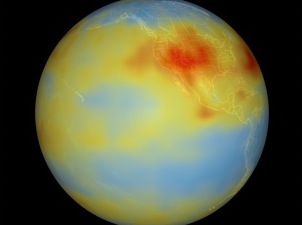Almost lost amid the Copenhagen media clutter was last week’s meeting of the American Geophysical Union in San Francisco. So this week we’re playing a little catch-up. Climate Watch contributor Molly Samuel has the last of three posts on some things that caught our attention at AGU.
The UN’s Collaborative Programme on Reducing Emissions from Deforestation and Forest Degradation in Developing Countries, or REDD, was a big topic the past two weeks at the climate conference in Copenhagen. Wealthy countries, including the United States, have put billions of dollars on the table to help developing countries use sustainable forestry practices.
Back here on the California climate beat, there’s forestry-related news, too. Scientists at the NASA Ames Research Center in Mountain View (see map, below) have been working with the California Energy Commission and the Air Resources Board to measure California’s greenhouse gas emissions for the state’s mandated greenhouse gas inventory under AB-32 (the Global Warming Solutions Act of 2006).

At the American Geophysical Union conference in San Francisco, NASA’s Christopher Potter shared information he’s gathered using MODIS, an imaging instrument that’s hitching a ride on NASA’s Terra satellite. Potter’s data shows that California’s ecosystems–forests, grasslands, croplands, wetlands, etc.–emit about the same amount of carbon that they absorb each year. And in wet years, they absorb considerably more. In an email Potter says, “the natural ecosystem sources can decrease or increase the net emissions of CO2 in the state by about 15%, depending on whether it is a normal precipitation year or a below-normal precipitation year, respectively.”
MODIS isn’t NASA’s only tool aimed at California as it circles the earth. AIRS, or Atmospheric Infrared Sounder, collects data from the troposphere (the layer of the atmosphere closest to the earth). NASA designed it to improve weather forecasting—the troposphere is where our weather happens–but it’s turned out to be an effective instrument for measuring carbons as they bubble up from the earth and circulate in the atmosphere.
Having collected seven years of data on carbon dioxide, carbon monoxide, and methane, scientists (and now you) can actually see where the carbons are coming from and where they go. NASA has posted animations showing the methane emitted by wildfires in California, and maps of carbon dioxide concentrations around the world.
3 thoughts on “NASA’s Carbon Trackers Yield New Maps”
Comments are closed.

If people want a green world.
then stop buying Chineese products.
No more “made by china” unless approved by a green label.
China frustrated the COP top, now people act themselves.
No more “made by china” unless approved by a green label.
Start yourselves, start today, start small!
If governments want to join, they shloud implement green labels.
We make china transparent! That should be done anyway.
How can you expect your government to take responsibility if you do not even bother about a green
label ?
Imagine a green label, next to “made by china” (hi hi)
People who care act. Hypocritical to ask your covernment and at the same time you want to buy communist party polluting toys
Craig, I wanted to make sure you had seen this excellent article from the Stockton Record re the impact of soot production on the Sierra snowpack. I don’t think this came up in the first segment of Forum this morning.
Thanks, yes, we did see that–and may ask Frank Gehrke about it at the snow survey today, since DWR is involved. I’ve been interested in the black carbon/snow albedo story for a while (so many stories, so little staff). I’m hoping we can get Sasha Khokha out to YOSE to do it in the next few weeks.